The Jazz‘s past two seasons have played out in similar fashion, with the team hovering around .500 and holding onto a play-in spot through the first half. However, in both 2022/23 and ’23/24, the front office clearly had little interest in pushing for a postseason berth, instead opting to sell off key rotation players at back-to-back trade deadlines. In 2023, it was Mike Conley, Jarred Vanderbilt, and Malik Beasley. In 2024, it was Simone Fontecchio, Kelly Olynyk, and Ochai Agbaji.
None of those players are stars, but they were important enough contributors that losing them played a major part in ultimately knocking the team out of the play-in hunt. The Jazz went 10-19 down the stretch in 2023 and just 5-25 to close out their most recent season.
In each case, Utah’s solid first-half play resulted in a few too many wins at the end of the season to earn a pick in the top half of the lottery. The team claimed the No. 9 overall selection a year ago and will pick at No. 10 this summer.
That’s not an ideal outcome for an organization that could badly use another young cornerstone player with star upside to add to its core. As constructed, the Jazz aren’t bad enough to be in the mix for a top-five pick and aren’t good enough to be a legitimate playoff contender.
The front office will have to move forward on one of three paths. Continuing to build incrementally through the draft and stockpile assets by trading non-star veterans is one option. Accelerating the rebuild by trading some of their excess future draft picks for an impact player to complement Lauri Markkanen is another. The third would involve taking a more significant step back by trading Markkanen and truly bottoming out, lining the team up to potentially pick much higher than No. 9 or 10 in next year’s draft.
The Jazz’s Offseason Plan
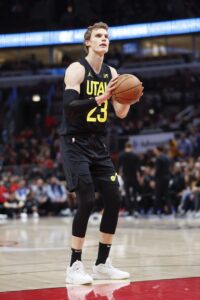 Of those three potential paths for Utah, I consider the safe, middle-of-the-road route (building through the draft, developing their young players, and hanging onto Markkanen) to be the likeliest, even if it won’t necessarily line the team up to draft a future star in 2025. I don’t think a Markkanen trade should be ruled out, whereas I view a blockbuster trade that accelerates the rebuild as an extreme long shot.
Of those three potential paths for Utah, I consider the safe, middle-of-the-road route (building through the draft, developing their young players, and hanging onto Markkanen) to be the likeliest, even if it won’t necessarily line the team up to draft a future star in 2025. I don’t think a Markkanen trade should be ruled out, whereas I view a blockbuster trade that accelerates the rebuild as an extreme long shot.
The Jazz aren’t just one move away from being a contender, so cashing in several of their future draft assets now doesn’t really make sense, even if they have the assets to make such a move. Utah has talked about focusing on player development and needs to get a better sense of what it has in its youngsters, including 2022/23 All-Rookie first-teamer Walker Kessler and 2023 first-rounders Keyonte George, Taylor Hendricks, and Brice Sensabaugh.
It’s also important to note that the Jazz still owe a first-round pick to Oklahoma City. Presumably, one reason why management hasn’t been eager to push for a play-in spot in recent years is its desire to ensure that pick falls into its protected range and stays with Utah — that just narrowly happened this year, as it was top-10 protected. The pick will be top-10 protected again in 2025 and top-eight protected in 2026. If it’s not conveyed by then, the Jazz’s obligation to the Thunder will be extinguished.
Those protection terms loom large over the Jazz’s plans going forward. To clarify, that first-rounder will never become unprotected; it won’t even turn into two second-rounders if Utah hangs onto long enough. It will simply stay with the Jazz, leaving OKC empty-handed, if it lands in its protected range for two more years.
A desire to hang onto that first-round pick may be the best argument in favor of trading Markkanen, who has emerged as a star since arriving in Utah, averaging 24.5 points and 8.4 rebounds per game with a .490/.395/.885 shooting line across two seasons.
His expiring contract limits his trade value somewhat, especially since he can’t realistically be extended prior to free agency by a team without cap room, as that team would be limited to offering a 40% raise on his $18MM salary for 2024/25. But the Jazz could still command a significant haul for Markkanen. And taking into account the draft assets they already control from the Donovan Mitchell and Rudy Gobert deals, along with a bump in value for their own 2025 and 2026 first-rounders without Markkanen on the roster, no NBA team would be better positioned to draft top-level talent in the coming years.
But there are plenty of arguments for keeping Markkanen too. For one, even with him leading the way, the Jazz have been a bottom-10 team in each of the past two years — they could potentially hang onto the first-rounder they owe the Thunder even if he sticks around.
Utah is also far better situated than most teams to extend Markkanen before he becomes a free agent in 2025. Because the Jazz will have cap room this offseason, they could renegotiate Markkanen’s contract before extending him, giving him a substantial bump on his $18MM salary and then extending him off the new figure, which would no longer make the limit of a 40% raise unpalatable. It’s not as if the Jazz will be going big-name shopping in free agency, so that’s a logical use of their cap room — they took the same route a year ago with Jordan Clarkson, renegotiating a raise for 2023/24 while tacking two new years onto his contract.
Markkanen won’t be eligible for a renegotiation until early August, but we should know by early July whether or not the Jazz plan to take that route — if they leave a significant chunk of cap room open through the first week of free agency, it’ll be a pretty strong signal that they’re preserving it for a Markkanen renegotiation.
For what it’s worth, this is the approach I expect the Jazz to take. It would allow the team to preserve a key asset without necessarily taking a future trade off the table — if Markkanen renegotiates as soon as he’s permitted to, he’d become trade-eligible again just in time for February’s deadline.
So if renegotiating and extending Markkanen is the plan, what would the rest of Utah’s offseason look like? It starts with their draft picks at No. 10, No. 29, and No. 32. Controlling those three selections gives the Jazz a ton of options in the trade market — they could move up or down from any of those spots, or could trade one or more of their picks for future assets if they’re not inclined to add three more rookies to their roster.
No. 10 is the pick most likely to be kept, and I’d expect to see the Jazz use that selection to zero in on a prospect who could help out on both ends of the floor. A guard like Stephon Castle is one possibility — ESPN has Castle going to Utah in its most recent mock draft, observing that his potential as a play-maker and versatile perimeter defender would make him a good fit next to smaller, offensive-minded guards like some on the Jazz’s roster. I also view three-and-D wings like Cody Williams and Ja’Kobe Walter as players who would make sense for Utah.
Depending on whether the Jazz want to retain Omer Yurtseven, Darius Bazley, and/or Kenneth Lofton – all of whom have non-guaranteed salaries – or any of their own free agents, they could potentially renegotiate Markkanen’s deal and still have a some cap room left over. However, that room would be limited, especially if they go up to the max for Markkanen (they might not have to, but that could allow them to construct an extension with a descending structure that gives them more cap flexibility in future seasons).
As noted above, the Jazz are very unlikely to be players in free agency except on minimum or near-minimum deals, so if they do have cap room available, I’d expect them to explore the trade market. There could be an opportunity to add a role player like they did a year ago when they used cap space to absorb John Collins‘ contract. Or they could take on another team’s unwanted contract with a draft pick attached.
Talen Horton-Tucker, Kris Dunn, Luka Samanic, and Kira Lewis are the Jazz players headed to free agency. Of those four, Dunn may be the best bet to return — he earned praise during the season from head coach Will Hardy for his locker room presence. Horton-Tucker has played a regular role in Utah for the past two seasons, but he isn’t a true point guard and isn’t a good enough shooter to attract much defensive attention off the ball. I’d be a little surprised if he’s back. Samanic and Lewis didn’t see regular rotation minutes last season.
As for the Jazz’s potential trade candidates, Clarkson is an obvious name to watch. His new extension dips down to just over $14MM per year for the next two seasons, making him an easier fit for contenders than he would’ve been on this year’s $23.5MM cap hit. And as he enters his age-32 season, he likely wouldn’t be opposed to ending up on a roster a little closer to contending.
Collins and Collin Sexton boosted their value as trade chips by turning in solid performances in 2023/24, but while their contracts are hardly albatrosses, they’re not bargains either. Collins is owed $26.58MM next season, with a $26.58MM player option for 2025/26, while Sexton will earn a total of $37MM+ over the next two seasons. That will make it hard to net a significant return for either player on the trade market, so I’d expect them stay put for now.
Salary Cap Situation
Guaranteed Salary
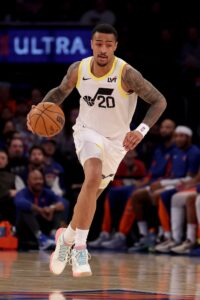 John Collins ($26,580,000)
John Collins ($26,580,000)- Collin Sexton ($18,150,000)
- Jordan Clarkson ($14,092,577)
- Lauri Markkanen ($6,000,000)
- Partial guarantee. Rest of salary noted below.
- Taylor Hendricks ($5,848,680)
- Keyonte George ($4,084,200)
- Walker Kessler ($2,965,920)
- Brice Sensabaugh ($2,571,480)
- Total: $80,292,857
Non-Guaranteed Salary
- Lauri Markkanen ($12,044,544)
- Partial guarantee. Rest of salary noted above. Markkanen’s salary will become guaranteed if he remains under contract through June 28.
- Partial guarantee. Rest of salary noted above. Markkanen’s salary will become guaranteed if he remains under contract through June 28.
- Omer Yurtseven ($2,660,000)
- Darius Bazley ($2,463,946)
- Bazley’s salary will become partially guaranteed for $400,000 if he remains under contract through July 25.
- Kenneth Lofton ($2,120,693)
- Lofton’s salary will become partially guaranteed for $400,000 if he remains under contract through July 25.
- Jason Preston (two-way)
- Total: $19,289,183
Dead/Retained Salary
- None
Player Options
- None
Team Options
- None
Restricted Free Agents
- Kira Lewis ($7,744,600 qualifying offer / $17,166,348 cap hold): Bird rights
- Total (cap holds): $17,166,348
Two-Way Free Agents
Note: Because they have finished each of the past two seasons on two-way contracts with the Jazz, Juzang’s and Potter’s qualifying offers would be worth their respective minimum salaries (projected to be $2,093,637 for Juzang and $2,168,944 for Potter). Those offers would include a small partial guarantee.
Draft Picks
- No. 10 overall pick ($5,485,080 cap hold)
- No. 29 overall pick ($2,520,120 cap hold)
- No. 32 overall pick (no cap hold)
- Total (cap holds): $8,005,200
Extension-Eligible Players
- John Collins (veteran)
- Talen Horton-Tucker (veteran)
- Extension-eligible until June 30.
- Lauri Markkanen (veteran)
- Collin Sexton (veteran)
- Extension-eligible as of September 3.
Note: Unless otherwise indicated, these players are eligible for extensions beginning in July.
Unrestricted Free Agents
- Talen Horton-Tucker ($20,938,000 cap hold): Bird rights
- Kris Dunn ($2,093,637 cap hold): Early Bird rights
- Luka Samanic ($2,093,637 cap hold): Early Bird rights
- Total (cap holds): $25,125,274
Cap Exceptions Available
Note: The Jazz project to operate under the cap. They would have to renounce two trade exceptions – worth $6,473,006 and $3,044,872 – in order to use cap room.
- Room exception: $8,006,000
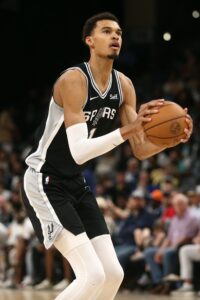 There has never been a player as tall and long as Wembanyama (he’s 7’4″ with a 8’0″ wingspan) who comes close to his unique blend of physical attributes and skills. While many seven-footers look stiff and awkward on the court due to their immense size, Wembanyama is agile, fluid and graceful, with excellent body control. He has a rare ability to precisely understand how his body can navigate a given space.
There has never been a player as tall and long as Wembanyama (he’s 7’4″ with a 8’0″ wingspan) who comes close to his unique blend of physical attributes and skills. While many seven-footers look stiff and awkward on the court due to their immense size, Wembanyama is agile, fluid and graceful, with excellent body control. He has a rare ability to precisely understand how his body can navigate a given space.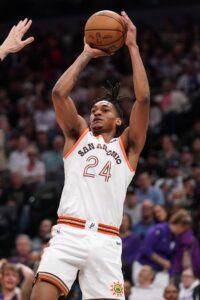 Devin Vassell
Devin Vassell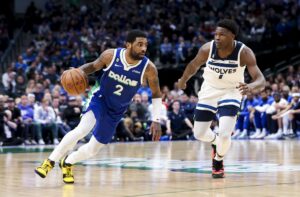 All the pieces came together in Minnesota during the Wolves’ second year with Gobert, as the team got off to a 17-4 start and held a top-three seed in the West for nearly the entire season, led by rising superstar
All the pieces came together in Minnesota during the Wolves’ second year with Gobert, as the team got off to a 17-4 start and held a top-three seed in the West for nearly the entire season, led by rising superstar 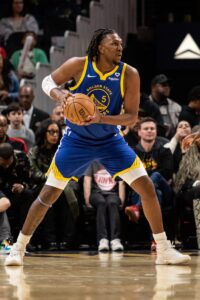

 Teams can only beat the opponents in front of them, so I’m not here to run down either of the East’s two clubs left standing. But if the two teams avoid injuries going forward, this series will represent a new challenge for the Celtics and Pacers.
Teams can only beat the opponents in front of them, so I’m not here to run down either of the East’s two clubs left standing. But if the two teams avoid injuries going forward, this series will represent a new challenge for the Celtics and Pacers.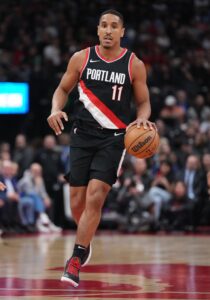 2023/24 was an injury-riddled season for the Blazers, who finished just 21-61, tied for the second-worst mark in franchise history. Trade acquisition
2023/24 was an injury-riddled season for the Blazers, who finished just 21-61, tied for the second-worst mark in franchise history. Trade acquisition 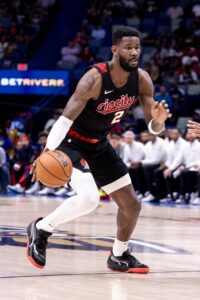 Deandre Ayton
Deandre Ayton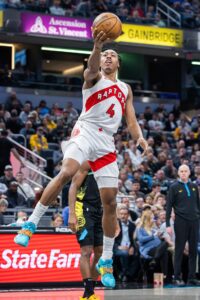 The good news about the Raptors giving up their 2024 first-round pick is that all of their first-rounders going forward will be unencumbered — if they had kept this year’s pick, they still would’ve owed a lightly protected 2025 first-rounder to the Spurs.
The good news about the Raptors giving up their 2024 first-round pick is that all of their first-rounders going forward will be unencumbered — if they had kept this year’s pick, they still would’ve owed a lightly protected 2025 first-rounder to the Spurs.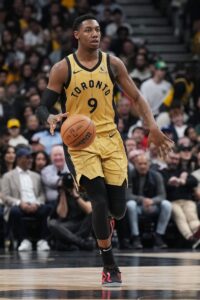
 Through the first six games of the Knicks/Pacers series, the home team has dominated. New York has a 3-0 record and a +43 margin at Madison Square Garden, but Indiana has been even better at Gainbridge Fieldhouse, posting a 3-0 record with a +50 margin.
Through the first six games of the Knicks/Pacers series, the home team has dominated. New York has a 3-0 record and a +43 margin at Madison Square Garden, but Indiana has been even better at Gainbridge Fieldhouse, posting a 3-0 record with a +50 margin.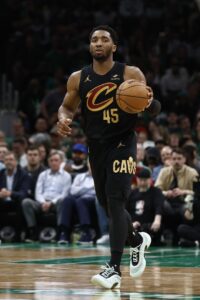 The Cavs will have to make a decision on head coach J.B. Bickerstaff, whose future with the club is said to be in “
The Cavs will have to make a decision on head coach J.B. Bickerstaff, whose future with the club is said to be in “